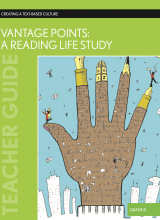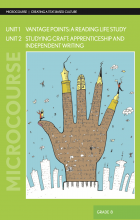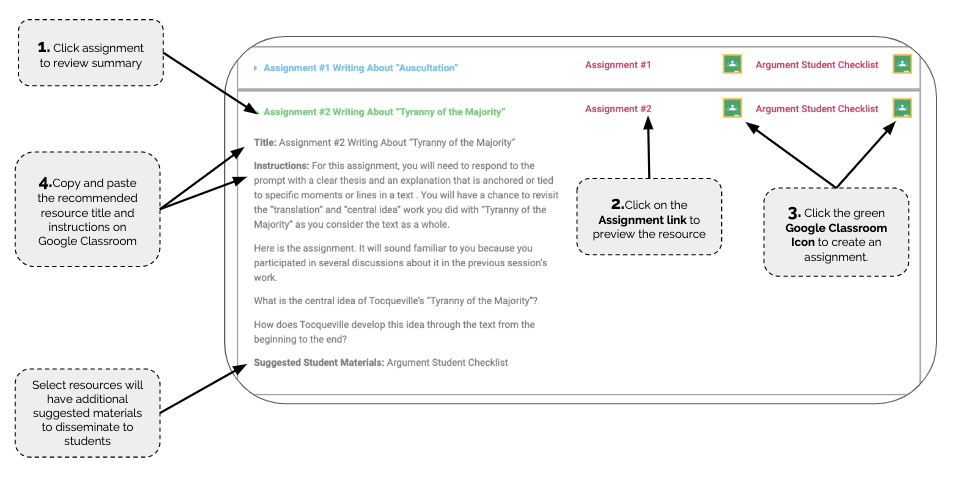Vantage Points: A Reading Life Study - Grade 8
Vantage Points is a two-part unit designed to both support independent reading as well as to initiate a study of narrative storytelling and point of view.
Part 1 features a basic and essential set of procedural work designed to help teachers launch (or re-launch) independent reading. These sessions focus largely on helping students begin their independent reading work and include instruction essentials related to rationales for reading, responses, and documentation including goal setting and reading logs.
In Part 2, students work with three short stories: “Norma” by Sonia Sanchez; “Harrison Bergeron” by Kurt Vonnegut Jr; and “Everything Stuck to Him” by Raymond Carver.


Table of Contents
Writing Tasks
Title: Rationales for Reading
Teacher Manual Instructions:
Session 1
Display a copy of “Rationales for Reading” for the class to see and distribute copies to students. Review the instructions at the top of the assignment sheet with the class and place students in groups of twos or threes.
Give students time to work with their partners to complete the “Rationales for Reading” worksheet.
- During this time, circulate around the room to discuss the quotations with the class and to address any questions students have about the work.
Title: Book Interview
Teacher Manual Instructions:
Session 3
Using the book you interviewed during the focus lesson, show students how to fill out the sheet. Answer any questions students have about the form and its terminology.
Give students time to fill out “The Book Interview” sheet. Each student should choose three books to interview from their group’s set.
Title: Book Pass
Teacher Manual Instructions:
Session 4
• Explain the purpose of a book pass:
» A book pass is another way to expose students to the texts available to them in the classroom library. A book pass requires students to use their book interviewing skills. A book pass is a chance for students to find titles to add to their “Books I’d Like to Read” list.
Distribute copies of the “Book Pass” sheet to students. (A copy-ready version can be found in the Appendix.)
Be sure you have one title for each student in the circle.
Give each student one book (or magazine). Tell students it doesn’t matter what they start with, because they will see all the books.
Choose a direction for passing.
After students receive a book, they should immediately record the author’s name (if the text is a book) and title on the “Book Pass” sheet.
Give students one minute to interview each book following the procedure established in the previous session.
At the end of one minute, call “pass.” At this time, students should make an entry in the comments column and pass the book to the next student.
Continue the book pass until each student has interviewed all the books.
Title: Book Recommendation
Instructions:
Session 5
Distribute copies of the “Book Recommendation” form to students and give them time to craft or begin crafting their first review.
Use this time to confer with students about this work. Be sure to refer them back to the models and the “What We Know About Book Recommendations” chart for ideas (including ideas for leads and conclusions) and answers to the questions they raise.
Title: Goals for My Reading Life
Teacher Manual Instructions:
Session 6
Use this time to review how to fill out the goals sheet. Be sure to show students how they can use the chart to generate ideas for answers to the “Goals” questions.
Take a moment to stress the value and function of the “Books I’d Like to Read” list. Point out that this list is a tool that serves the same function as a bedside table for some readers: It is a place to store titles or books that are “next in line.” Remind the class that readers constantly have their eyes open for “next” texts. A “Books I’d Like to Read List” is a planning tool—a way to prevent aimless and unproductive castings around for new reading materials.
Explain that at the beginning of each marking period, each student will fill out a new goals sheet. Then, at the end of that marking period, students will take a few minutes to review their goals statements and reflect on their efforts to meet them.
Answer any questions students have about the “Goals for My Reading Life” forms.
Give students time to complete the form and set a deadline for submission. You may decide to photocopy these to keep a set for yourself. Return the forms to students during the next session and have them attach the form to a page in their notebook.
Title: Writing Like Sonia Sanchez A First-Person Narrative
Teacher Manual Instructions:
Session 9
Once, you’ve reviewed the assignment, read “Norma” aloud, once again.
If you display a copy of the story as you read, this will give you a way to mark and annotate Sanchez’s beginning and ending, her use of dialogue and description, as well as her manipulation of time.After the reading or at intervals throughout, engage students in a discussion of “Norma” that has as its aim describing Sanchez’s use of dialogue, description, time, etc. in the story.
Title: Writing Like Kurt Vonnegut Jr . A Third-Person Narrative
Teacher Manual Instructions:
Session 14
Read “Harrison Bergeron” aloud, once again. If you display a copy of the story as you read, this will give you a way to mark and annotate Vonnegut’s beginning and ending, his use of dialogue and description, as well as his manipulation of time.
After the reading or at intervals throughout, engage students in a discussion of “Harrison Bergeron” that has as its aim describing Vonnegut’s use of dialogue, description, time, etc. in the story.
Title: A Story-Within-A-Story Writing Like Raymond Carver
Teacher Manual Instructions:
Session 18
Answer any questions students have about the assignment and then give them time to write. Tell students that they should be prepared to share drafts of their third-person, story-within-a-story during the work period and closing meeting of the next session.
Use this time to confer with students about their work.
Charts for Discussion
Title: What We Know About Book Recommendations
Teacher Manual Instructions:
Session 5
Ask students to turn to the next blank page in their notebooks and to title the page “Book Recommendations.”
Ask students if they have ever read a book recommendation before—perhaps in a bookstore where bookstore employees have posted short blurbs endorsing a text or maybe online on a site like amazon.com or teenink.com. Ask volunteers to say what they know about recommendations and the kinds of things readers write in them. Jot these items on a chart titled “What We Know About Book Recommendations.”
Next, display or distribute copies of some model book recommendations. This will ensure that students have a connection with the content and will help expedite their understanding of the form. You can find model book reviews at sites like goodreads.com, teenink.com, or amazon.com.
Read two or three sample reviews aloud to the class. Use the following questions to guide students’ study of these models:
What do readers do in book recommendations (or book reviews)?
How do they begin?
How do they end?
What do they do in the middle?
Jot these questions on the board. Use these questions to drive the class’s discussion about each of the examples. Capture the class’s answers to the questions on the “What We Know About Book Recommendations” chart.
Title: Significant Moments in “Norma”
Teacher Manual Instructions:
Session 7
After you have finished the reading, take a minute or two to have volunteers share the moments they marked. Capture these on a two-column chart titled “Significant Moments in ‘Norma.’” Place summaries of the text selections in one column and page and line numbers in the other so that the list can serve as a kind of common index to the story.
Title: First-Person Point of View
Teacher Manual Instructions:
Session 9
Review the “characteristics” of the first-person point of view with the class and then test them against Sanchez’s “Norma.”
Afterwards, answer any questions students have about first-person point of view or about “Norma” as an example of first-person point of view.
Explain to students that during this session’s work period, they will have a chance to try their hands at writing a brief story using first-person point of view.
Title: Significant Moments in “Harrison Bergeron”
Teacher Manual Instructions:
Session 11
After you have finished the reading, take a minute or two to have volunteers share the moments they marked. Capture these on a two-column chart titled “Significant Moments in ‘Harrison Bergeron.’” Place summaries of the text selections in one column and page and line numbers in the other so that the list can serve as a kind of common index to the story.
Title: Third-Person Point of View
Teacher Manual Instructions:
Session 14
Review the “characteristics” of the third-person point of view with the class and then test them against “Harrison Bergeron.”
Afterwards, answer any questions students have about the third-person point of view or about “Harrison Bergeron” as an example of third-person point of view.
Explain to students that during this session’s work period, they will have a chance to try their hands at writing a brief story using the third-person point of view.
Title: Significant Moments in “Everything Stuck to Him”
Teacher Manual Instructions:
Session 16
After you have finished the reading, take a minute or two to have volunteers share the moments they marked. Capture these on a two-column chart titled “Significant Moments in ‘Everything Stuck to Him.’” Place summaries of the text in one column and page and line numbers in the other so that the list can serve as a kind of common index to the story.
Title: Third-Person, Story-Within-A-Story
Teacher Manual Instructions:
Session 18
Review the “characteristics” listed under the “Outside” story (the story of the father and daughter in Milan) with the class and then test them against those portions of Carver’s story.
Afterwards, ask the class to help you create a list of characteristics for the “Story-Within-the-Story” (or “inside” story). There are some interesting questions to ask about this story. For example: What point of view is this story told from? Whose thoughts and feelings does the narrator give us access to in this story? Why is this story told in the third-person?
Explain to students that during this session’s work period, they will have a chance to try their hands at writing a story-within-a-story using the point of view of their choice.
Checks for Understanding
Title: Why Read? What the Research Says
Teacher Manual Instructions:
Session 2
Reconvene the class and facilitate a discussion where students share (and refine) their conclusions. Capture the class’ thinking on a chart titled “Why Read? What the Research Says.”
Remind students of procedures for cleaning and exiting the room, including how to store the literacy notebooks.
Title: “Norma” Retelling
Teacher Manual Instructions:
Session 7
Reconvene the class and ask groups to share their retellings.
After groups have shared, ask the class to help you compose a single, class retelling of the story that reflects the best of the retelling work students just shared. Capture this retelling on a chart. (You will need this retelling in the next session.) Remind students that this class retelling is intended to give students one more opportunity to synthesize and reread “Norma” as preparation for the work ahead.
Title: “Harrison Bergeron” Retelling
Teacher Manual Instructions:
Session 12
Ask the class to help you construct a retelling of “Harrison Bergeron.” The work from the previous session should guide the shape of this retelling. Capture the class’ retelling of the story on a chart. This task also serves as an occasion for getting students to revisit and reread portions of the text as they work to clarify and remember what happens in Vonnegut’s story.
Independent Reading
Title: Book Interview
Instructions:
Display a copy of the “Book Interview” for the class to see and distribute paper copies to students. (See example nearby or the Appendix for a copy-ready version.)
Using the book you just interviewed, show students how to fill out the sheet.
Pass out three books to each student.
Give students time to make an entry on their “Book Interview” sheet for each of the three titles.
Title: Books I’d Like to Read
Teacher Manual Instructions:
Organize students’ desks into one large circle, or two or three smaller circles.
Ask students to get out their notebooks.
Explain that the writer’s notebook will play an important role in their reading work and that writers often use their notebook to reflect on and track elements of their reading life as well.
Ask students to turn to the next blank page in their notebook.
Ask students to place the following heading at the top of that page: “Books I’d Like to Read.” Remind them to add this entry to the table of contents as well. Model this using your own notebook. Use the example above as a guide.
Explain that this page is the place where you write down books that you want to be sure to read. In short, it’s a remembering tool or a decision-making tool.
“Book Interview” forms students completed during the last session back to the class. Give students a moment to review these and, if they interviewed a book they think they might like to read, to enter it on the list.
Title: Book Pass
Teacher Manual Instructions:
• Explain the purpose of a book pass:
» A book pass is another way to expose students to the texts available to them in the classroom library. A book pass requires students to use their book interviewing skills. A book pass is a chance for students to find titles to add to their “Books I’d Like to Read” list.
Distribute copies of the “Book Pass” sheet to students. (A copy-ready version can be found in the Appendix.)
Be sure you have one title for each student in the circle.
Give each student one book (or magazine). Tell students it doesn’t matter what they start with, because they will see all the books.
Choose a direction for passing.
After students receive a book, they should immediately record the author’s name (if the text is a book) and title on the “Book Pass” sheet.
Give students one minute to interview each book following the procedure established in the previous session.
At the end of one minute, call “pass.” At this time, students should make an entry in the comments column and pass the book to the next student.
Continue the book pass until each student has interviewed all the books.
Title: Goals for My Reading Life
Teacher Manual Instructions:
Ask students to turn to the “Books I’d Like to Read” page in their notebooks.
Display a copy of “Goals for My Reading Life” for the class to see and distribute copies to students. Using the display copy, show students how to fill out the goals sheet. Show them how they can use the information charts created in earlier sessions to generate ideas for answers to the “Goals” questions.
Explain that at the beginning of each six weeks, each student will fill out
a new goals sheet. At the end of each six weeks, students will take a few minutes to review their goals statements and reflect on their efforts to meet them.Answer any questions students have about the “Goals for My Reading Life.”
Give students time to complete the sheet. (They should only fill out the goal-setting portion of the assessment at this point.) Tell them that these will be collected at the end of the closing meeting and that you will return these at the next session. (You may decide to photocopy a set for yourself.)
Return the sheets to students during the next session and have them attach the sheet to a page in their notebook.
Title: Reading Log
Teacher Manual Instructions:
Write “Reading Log” on the board.
Explain to the class that a reading log is simply a place where a reader keeps track of all the reading he or she has done over a period of time.
Ask students to turn to the next blank page in their notebooks and to reserve at least three pages for the reading log.
On a piece of chart paper or another display, show students how to set up a “Reading Log” in their writer’s notebook. (See example on next page.) They should be sure to enter it in their table of contents as well. You may decide to distribute sticky notes so that students can flag this page.
Explain to students that they should make an entry in their log only after they have finished a book. You will need to negotiate with students how to handle the entry of magazine readings (for example, entire issues versus individual articles).
After students have set up the log, including proper headings, creating the grid, etc., show students how to make an entry.
Answer any questions students have about the reading log.
Tell students that they can make their first entry in their reading log at the beginning of independent reading.
